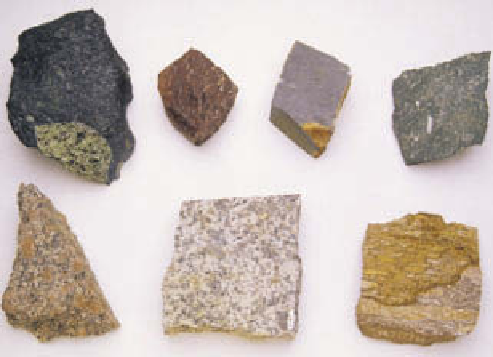Geoscience Reference
In-Depth Information
ability of mineral-magma reactions to form new mineral
species, formerly set out in Bowen's Reaction Series, is now
recognized in general fractional crystallization, ionic
substitution and solid solution processes (see
Figure 13.8
).
The cooling rate and silicate content of igneous rocks
also create textural as well as chemical properties. Rapid
cooling, especially of high-temperature rock suddenly
exposed to low temperatures, pre-empts the growth of
large crystals and forms fine-grained rocks such as basalt.
Even within a specific magma, some minerals will cool
faster, leaving others to enlarge. Larger crystals in finer
matrices create a
porphyritic
texture which becomes
pegmatitic
if they grow very large. Slow cooling gives the
characteristic coarse-grained texture to granite, associated
with subsurface emplacement of low-temperature
magmas. Volatiles driven off during cooling leave empty
pockets which create a
vesicular
texture if they survive or
amygdaloidal
texture when infused with slower-cooling
melt products or gases (
Plate 12.1
).
Plate 12.1
Igneous rocks (clockwise from top left). Basalt
(dark green) contrasts with very fine-grained dark-grey basalt.
Vesicular basalt. Rhyolite. Andesite, with white phenocrysts
providing porphyritic tecture. Ignimbrite or ash-flow tuff, with
slower-cooling fragments drawn out in the flow direction.
Dartmoor Granite, with white feldspar. Shap Granite, with pink
porphyritic feldspar. Both granites also contain grey/translu-
cent quartz crystals and black biotite (mica). For scale,
Dartmoor Granite measures 10
THE ROCK CYCLE (1) IGNEOUS
10 cm.
Photo: Ken Addison
Magma mineralogy and specific temperature/pressure
environments, found at a predictable and restricted range
of sites in the global tectonic framework, determine the
style, location and lithology of igneous activity. Magma
which solidifies before reaching the surface is
intrusive
in
style and
plutonic
in location; magma which reaches the
surface is
extrusive
in style, with an
effusive
(flowing) or
explosive
(eruptive) nature. The characteristic mineralogy,
magma class, texture, viscosity and surface/subsurface
formation of the principal igneous rocks are identified in
Figure 12.3
.
These distinctions also extend to the style of
eruptive activity and resultant igneous landforms.
(melting of country rock) enlarge them into substantial
plutons or underground reservoirs. Batholiths are the
largest plutons, found in the cores of island arc complexes,
subduction zones and some extension orogens. Individual
Cenozoic batholiths of 10
2-5
km
3
contribute to 10
6
km
3
of
intrusive assemblages in the Andes. The largest North
American Mesozoic batholiths extend over 1,600 km in
the Yukon-British Columbia-Washington coast range.
Magma pipes which feed batholiths or surface extrusions
intrude country rocks
accordantly
as
sills
, thickening
locally into sizeable
laccoliths
, and
discordantly
as
dykes
or fault-directed
cone sheets
. The latter intrude rocks
above the rising diapir and may feed volcanoes. Inter-
mediate or basic magmas develop as the original ground
surface is approached. Solidified plugs of volcanoes
beneath extrusive lava flows mark the intrusion/extrusion
boundary
(
Figure 12.4a
).
The full nature of intrusion becomes apparent when it
is exhumed as erosion removes the
overburden
rocks. The
intrusion usually forms prominent surface relief by virtue
of its high mechanical strength. Its mineral species and
radioactive isotopes also provide good estimates of the
extent and rate of erosion since emplacement. Tens of
kilometres of crust stripped off since the late Palaeozoic
have partially exhumed the Cornubian granite batholith
Intrusive activity
Intrusions
create a plumbing system of underground
magma reservoirs and pipework which connects
asthenosphere/lithosphere melts with diapirs and surface
extrusions. Two-thirds of new magma is thought to be
intrusive. Large igneous intrusions are formed mostly by
the viscous flow of low-temperature, silicate-rich granitic
magma or more 'solid' lithosphere under relatively thick
continental crust by subduction or thermal diapirism. The
material permeates the
country
(surrounding) rock at
depth through existing voids, either as magmatized
continental granitic crust or as the residual part of a less
silicic melt. Sustained flow, magma buoyancy and
anatexis









































